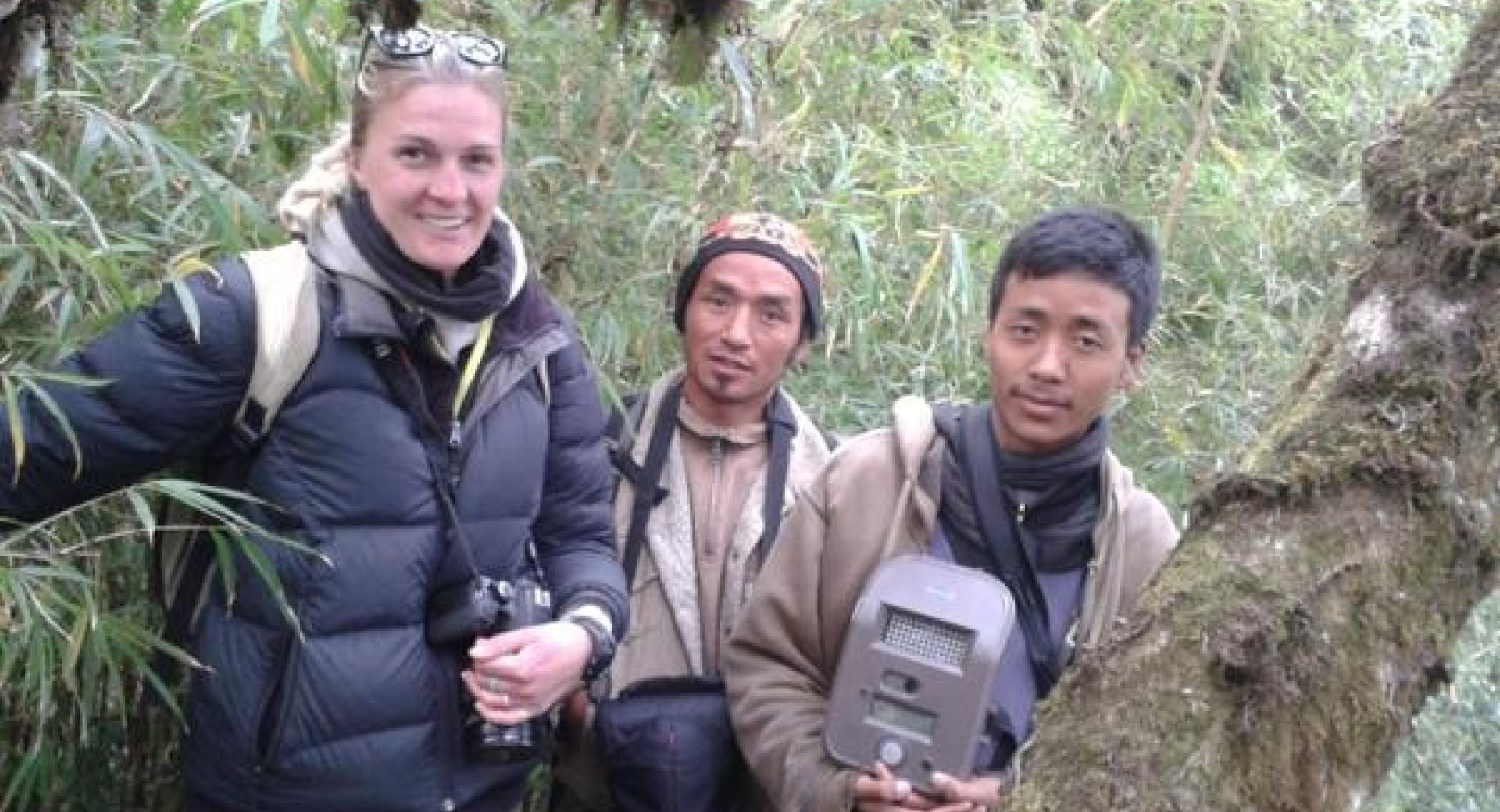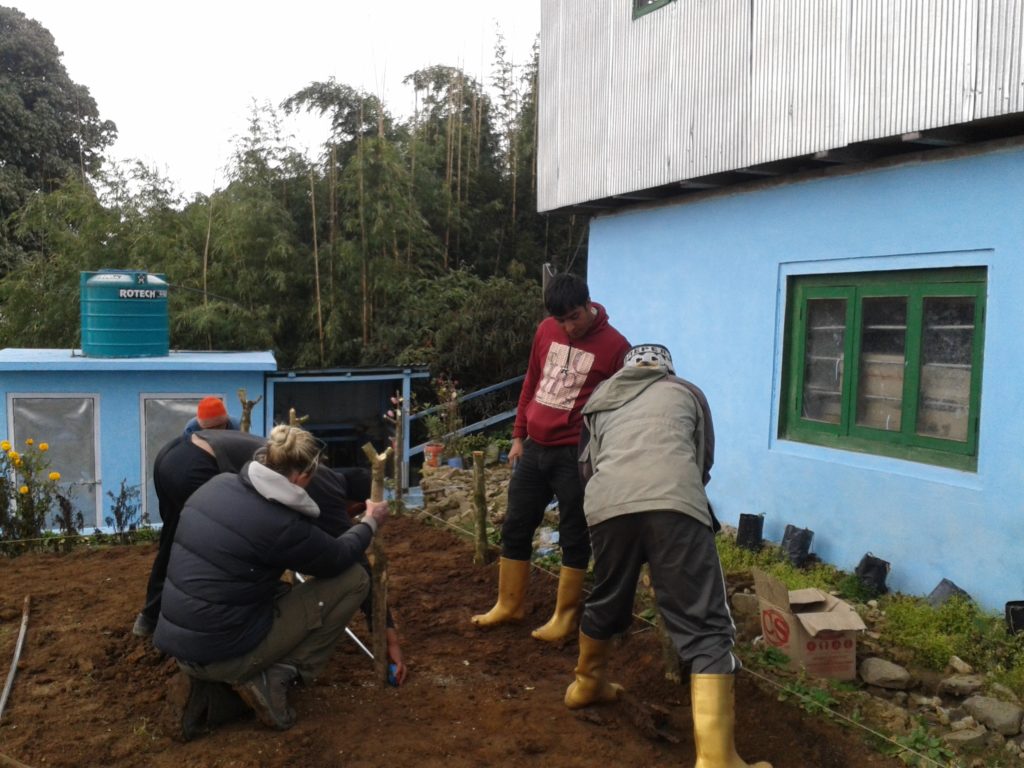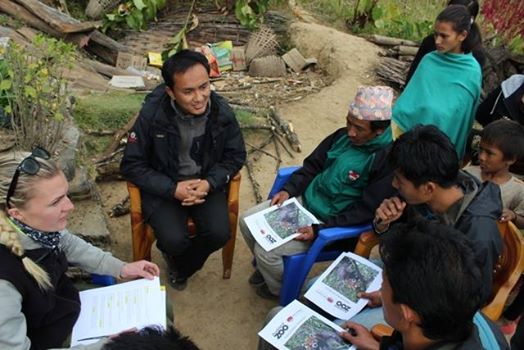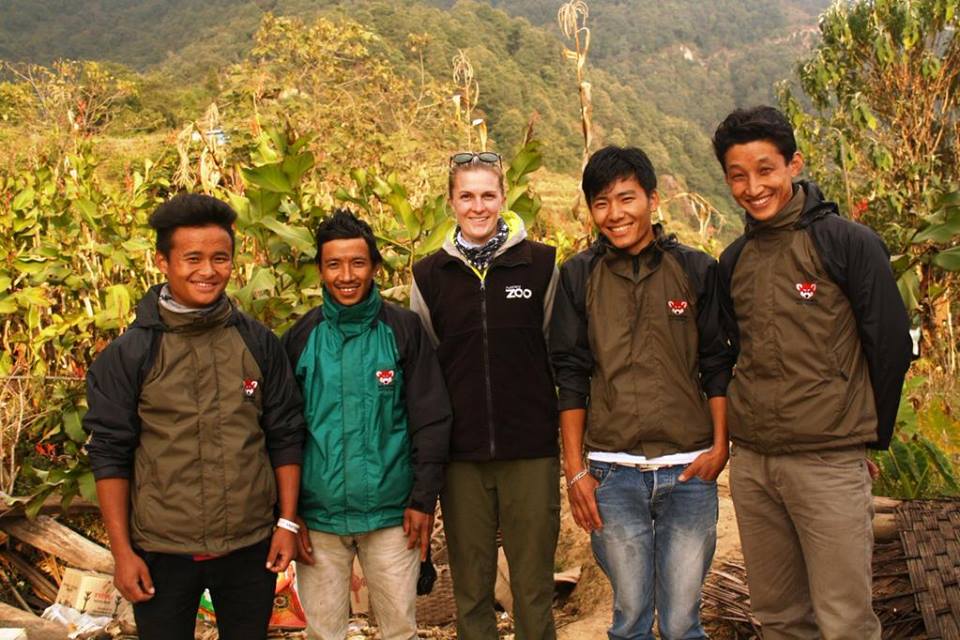
Red panda keeper, Anneke Haworth of Auckland Zoo, visited the Red Panda Network field team in December 2014. Here is her story, in her words…
Anneke and forest guardians working with camera trap.
Nepal – what a place! For the last six weeks I have been traveling in eastern Nepal, tagging along with Sonam Tashi Lama from Red Panda Network, and RPN field partners – experiencing, and hopefully contributing to their fantastic conservation work.
My name is Anneke Haworth and I am a carnivore keeper at Auckland Zoo in New Zealand, working closely with our five Nepalese red pandas. Since 2010, Auckland Zoo has supported Red Panda Network (RPN), through both sponsorship and staff visits.
I was lucky to visit Nepal last year to further develop our relationship with RPN and to see first-hand how their work is making a difference to the endangered red panda.
Our journey started in Taplejung, in a village called Tiringe. We stayed in a remote settlement, with only the necessities a rural family of the eastern hills would need. Dal Bhat (rice and lentil soup) are the staple foods across the mountain villages. Solar power gives villagers light at night and the ability to charge cell phones, but not much else. This means communities such as those in Tiringe rely heavily on the forests that surround their settlements, especially for wood to light fires for cooking, warmth and many other things.
The forest here is also home to the red panda. While in Tiringe, Taplejung, RPN and their field partner HCF (Himali Conservation Forum), conducted community awareness workshops designed to get the community on board with helping conserve red panda. The workshops inform local community members about the threats to red panda survival, so that individuals can then make more informed decisions on what they take from the forest and where they take it from.
 Anneke helping community to build nursery
Anneke helping community to build nursery
We helped to start building a nursery which will harvest plants that will benefit the local communities, as well as bamboo for the red pandas and other plants that will be used for reforestation efforts in the near future.
It was great to see how involved the local people were and how excited they were about the development of the nursery! The chairman of the community expressed hope that more nurseries could be created within other households in the area, in the near future.
While we were there, we walked for about an hour down to a primary school where Sonam (RPN) and Bishal (HCF) took a class each, combining several school levels. They spoke about red panda conservation and how the children can make a difference. The children were intent – watching and listening to Sonam who did an excellent job of keeping 50 kids focused and excited about what he was talking about.
Outside of school many of these children have the responsibility of taking their families’ livestock out for fresh grazing. This too is a major threat to the red panda, as cattle will destroy forest just by walking through it, and also enjoy munching on bamboo – an extremely important part of red panda diet. Basically put, red pandas can’t live without large quantities of fresh bamboo.
With this knowledge, the kids can also make wiser decisions about where to graze their livestock, and being excited about the lesson, are likely to pass this information on to their families spreading the message further. These education lessons and workshops are just one of the ways RPN spreads their message to the many villages in the forest connecting the PIT (Pancthar-Ilam-Taplejung) corridor, where RPN concentrates their work. I was lucky to witness all of it in person.

Anneke training Forest Guardians.
Aside from this important work, monitoring red panda and their habitats is carried out by the ever important Forest Guardians – local people employed by RPN. They have great knowledge of the forest and the threats to it, but also great relationships with the people so they can help to carry the conservation message and get villagers on board. I spent time with Forest Guardians in all three districts and was happy to see how devoted and committed they are to the job – a job which is certainly not easy. Auckland Zoo is proud to contribute to supporting the Forest Guardians within Taplejung and hopefully we can take this further since my visit.
The last stretch of our journey took us to Dobate, Ilam, a beautiful place perfect for those wanting to experience a comfortable and cultural Nepal, and have the amazing experience of seeing red panda in the wild.
On our second day in the forest, we spent several hours exploring the transect lines monitored by the Forest Guardians and examining red panda habitat. We found plenty of evidence of red pandas being around (scat and browsing) but the mist was settling in for the afternoon, so we decided to call it a day. However on our walk back up to the road, a young Forest Guardian, Nim Dawa, with laser vision, helped us spot a red panda moving through a tree ahead of us. I was absolutely delighted!
We stayed with the panda around an hour, keeping some distance so as not to disturb it too much. It stayed quite hidden amongst the leaves in the tree for most of the time, which led us to believe it was a young one – perhaps still gaining confidence after leaving mum. Dobate forests are ideal panda habitat. Being able to witness firsthand how red panda live in the wild has also shown me that we are doing a really good job with what we provide for our red panda exhibit back at Auckland Zoo.
While in Dobate, the RPN team held the annual refresher training for the 14 forest guardians of Ilam. It was really great to be part of this training and see all they are taught for their hard work in the forest. I gave a class on the handling of injured animals to help equip the guardians – should they come across an injured red panda or other wild animal. I thoroughly enjoyed meeting them all and the practical training in the forest.
Aside from our conservation work, we took time to visit some great attractions in all districts. Nepal is an excellent place for those wanting to experience life outside of western culture without having to spend a fortune. Nepalese people are wonderfully kind and always welcoming. The eco trips to Ilam provide beautiful scenery, comfort and a glimpse of Nepalese culture and life.
 Anneke with Forest Guardians
Anneke with Forest Guardians
Overall, my experience and work here in Nepal has shown me first-hand the immediate threats to red panda and how Red Panda Network is managing these. The staff is so passionate about what they do and are excellent at forming good relationships with the communities to get them on their side.
On behalf of Auckland Zoo I feel very proud to say we support Red Panda Network, who are focused on both red panda conservation and also the livelihoods of the people sharing the forest with these beautiful animals.
This trip has been a once-in-a-lifetime opportunity and extremely memorable, and I look forward to continuing to help grow the great relationship Auckland Zoo has with Red Panda Network.
